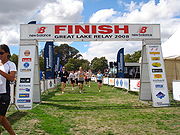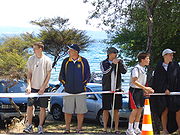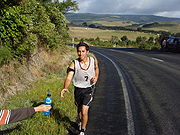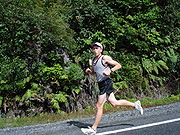
Great Lake Relay
Encyclopedia

Taupo
Taupo is a town on the shore of Lake Taupo in the centre of the North Island of New Zealand. It is the seat of the Taupo District Council and lies in the southern Waikato Region....
, New Zealand
New Zealand
New Zealand is an island country in the south-western Pacific Ocean comprising two main landmasses and numerous smaller islands. The country is situated some east of Australia across the Tasman Sea, and roughly south of the Pacific island nations of New Caledonia, Fiji, and Tonga...
on the third Saturday of February. Each team consists of ten to eighteen members, either running or walking to complete the eighteen 4.7 km to 14.4 km legs around the largest lake in Australasia
Australasia
Australasia is a region of Oceania comprising Australia, New Zealand, the island of New Guinea, and neighbouring islands in the Pacific Ocean. The term was coined by Charles de Brosses in Histoire des navigations aux terres australes...
, Lake Taupo
Lake Taupo
Lake Taupo is a lake situated in the North Island of New Zealand. With a surface area of , it is the largest lake by surface area in New Zealand, and the second largest freshwater lake by surface area in geopolitical Oceania after Lake Murray ....
.
In 2009 this event, currently sponsored by New Balance
New Balance
New Balance Athletic Shoe, Inc. , best known as simply New Balance, is a footwear manufacturer based in Boston, Massachusetts, United States of America. It was founded in 1906 as the New Balance Arch Support Company...
, will be held on Saturday 21 February, and will be celebrating the 14th running of the event which started back in 1995.
With over 5000 registered amateur
Amateur
An amateur is generally considered a person attached to a particular pursuit, study, or science, without pay and often without formal training....
and professional
Professional
A professional is a person who is paid to undertake a specialised set of tasks and to complete them for a fee. The traditional professions were doctors, lawyers, clergymen, and commissioned military officers. Today, the term is applied to estate agents, surveyors , environmental scientists,...
runners from all over Australasia taking part in the race each year, it is the biggest event of its type in the Southern Hemisphere
Southern Hemisphere
The Southern Hemisphere is the part of Earth that lies south of the equator. The word hemisphere literally means 'half ball' or "half sphere"...
. While there are prizes awarded to the winners of the relay, and $150,000 worth of spot prizes given away, most of the runners take part just for the joy of team building
Team building
Team building refers to a wide range of activities, presented to businesses, schools, sports teams, religious or nonprofit organizations designed for improving team performance...
and participating.
Following the prize giving, a post-race party is held in the Great Lake Centre, overlooking Lake Taupo, with plenty of drinks available.
Qualifying
The Great Lake Relay is open to all runners and walkers, both maleMale
Male refers to the biological sex of an organism, or part of an organism, which produces small mobile gametes, called spermatozoa. Each spermatozoon can fuse with a larger female gamete or ovum, in the process of fertilization...
and female
Female
Female is the sex of an organism, or a part of an organism, which produces non-mobile ova .- Defining characteristics :The ova are defined as the larger gametes in a heterogamous reproduction system, while the smaller, usually motile gamete, the spermatozoon, is produced by the male...
, of any age, ability and from any nation
Nation
A nation may refer to a community of people who share a common language, culture, ethnicity, descent, and/or history. In this definition, a nation has no physical borders. However, it can also refer to people who share a common territory and government irrespective of their ethnic make-up...
. For safety reasons however, the event is limited to the first 450 teams to complete an entry form, and pay the entry fee.
The Athletics New Zealand 100km Championships, and the New Zealand 100 Mile Ultra Runners Road Championships are also incorporated into this event.
Grades
Teams or individuals may choose to participate in any one of the following five grades.- Runners: Running teams consist of 10-18 members. Each team member must run one or two legs.
- Walkers:Walking teams consist of 10-18 members who must walk one or two legs.
- Composite Teams (Runners and Walkers):Composite teams consist of 10-18 members who must complete one or two legs each. Legs 1, 3, 4, 9, 10, 15 & 16 must be completed by walkers. Team members may walk or run legs 2, 5, 6, 7, 8, 11, 12, 13, 14, 17 & 18.
- Two Person Team (2x50km):Both members of this team must complete 50 km of the relay course, consecutively. This course starts 5 km into the fifth leg.
- Individual (100 km):Competitors must be current members of Athletics NZ to be eligible for the NZ championship title. Each individual competitor must start 5 km into the fifth leg, and complete 100 km of the course by 6.00pm of the race day.

Start time
The relay uses a staggered “wave start” beginning at 9:00 pm Friday night for the walkers who have an estimated team time greater than 18 hrs. At 10:30 pm, the walkers who estimate to finish in less than 18 hrs, along with the composite teams with an estimated team time of more than 17 hrs 30 mins begin. The rest of the composite teams commence the race at 11:30 pm.The first batch of runners starts at 2:00 am Saturday morning. These are the running teams who have an estimated team time greater than 14hrs. The final wave starts at 3:00 am. This includes the rest of the running teams, as well as the individuals and two person teams.
Course Description
| Leg Number | Brief Leg Description | Stage Classification | Distance |
|---|---|---|---|
| Leg 1 | Start outside the Tennis Club on Redoubt Street. Proceed to State Highway 1 then uphill for 1.0 km. Undulating and gradual uphill. Flat for 1.2 km, then gradual uphill for 1.0 km. Undulating to finish. | Average | 14.4 km |
| Leg 2 | Flat with gradual downhill's for 5.0 km. A long 2.2 km uphill, followed by long uphill and downhill sections for the remainder of the leg. | Hard | 14.1 km |
| Leg 3 | Large rolling hills for the first 3.8 km, then easy gradual downhill for the remaining 6.3 km. | Average | 10.1 km |
| Leg 4 | Very gradual uphill with some downhill's for 4.0 km, followed by an easy 3.0 km downhill section with some flats. Undulating to finish. | Average | 8.3 km |
| Leg 5 | Easy uphill for 0.9 km followed by rolling hills for 4.1 km. Slight rise then downhill 1.0 km, over bridge, then hard climb for 4.1 km to finish. | Hard | 10.1 km |
| Leg 6 | Flat for 1 km with an easy downhill for 1 km. A small rise followed by another 1.1 km downhill. A steady climb then downhill for 1 km and undulating to finish. | Average | 8.4 km |
| Leg 7 | Undulating for 5.0 km with a 500m climb to finish. | Average | 5.5 km |
| Leg 8 | 2.0 km downhill and 500m flat. Long gradual downhill and flat sections. Finish with a couple of hills. | Easy | 7.0 km |
| Leg 9 | Gradual downhill for 1.5 km followed by undulating hills. A hard 3.0 km climb up the Kuratau Hill, followed by a small dip and climb to finish. | Hard | 7.4 km |
| Leg 10 | Steep downhill for 2.0 km followed by an undulating section of 1.0 km and a climb for 0.9 km. Easy undulating section to finish. | Easy | 7.1 km |
| Leg 11 | An undulating section for 1.3 km followed by a long downhill section of 3.2 km to the Tokaanu flats. All the rest of the leg is flat. | Average | 10.9 km |
| Leg 12 | Flat to State Highway 1 for 500m. Turn left, stay on the right hand side of State Highway 1, flat to finish at the Motuoapa Reserve. | Average | 10.2 km |
| Leg 13 | Flat for 3.0 km to the Tauranga-Taupo River Bridge and flat to finish. | Average | 8.6 km |
| Leg 14 | Leg is flat and undulating. The last 4.3 km of are very dangerous due to narrow and windy sections of road. | Dangerous | 7.4 km |
| Leg 15 | Flat to Hatepe for 2 km, then a steep hard climb up the famous Hatepe hill for 2.7 km. Flat to finish. | Average | 6.1 km |
| Leg 16 | Very easy downhill for 6.0 km followed by a steep downhill for 1.3 km into Waitahanui. Flat for 600m to finish. | Easy | 8.0 km |
| Leg 17 | Flat for 3.7 km passing through Five Mile Bay. 1 km climb to finish. | Easy | 4.7 km |
| Leg 18 | Gradual downhill to Taupo, and into Tongariro Domain to finish. | Average | 7.5 km |
Note: All distances are + or - 0.2



Event Records
The race organizers keep a standard time clock for all entries, though official timekeeping ceases after 6.00pm on Saturday.Current course records, as of 2007, are:
Relay
| Grade | Team | Town | Time | Year |
|---|---|---|---|---|
| Runners | Adidas Adistars | Auckland | 8:42:47 | 2002 |
| Walkers | Team New Balance | Whangarei | 13:47:00 | 2007 |
| Composite | Bush Survivors | Woodville | 12:49:08 | 2002 |
| Two person team (2x50km) | Riverhead 50k | Riverhead | 8:56:18 | 2005 |
| 100 km Solo Walker | Peter Baillie | Plimmerton | 12:25:00 | 2005 |
New Zealand
| Grade | Winner | Time | Year |
|---|---|---|---|
| NZ 100 km Championships: Solo Men | Mark Bright | 8:09:23 | 2007 |
| NZ 100 km Championships: Solo Women | Carrie White | 9:45:37 | 2007 |
| NZ 100mile Championships: Solo men | Vesa Murto | 16:49:03 | 2002 |
| NZ 100mile Championships: Solo women | Carolynn Tassie | 18:48:30 | 2002 |
International
| Grade | Winner | Country | Time | Year |
|---|---|---|---|---|
| 100 km: Solo Men | Colin Oliver | Australia | 7:44:41 | 2004 |
| 100mile: Solo Male: | Yiannis Kouros | Australia | 12:35:48 | 2002 |
General Reference
- Official Great Lake Relay website
- Course map
- Great Lake Relay Results
- Sportzhub website
- Training program

